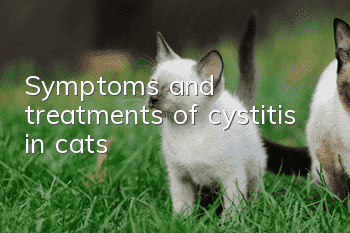Symptoms and treatments of cystitis in cats

Cat cystitis refers to inflammation that occurs in the bladder. It is mainly divided into two categories: acute cystitis and chronic cystitis. Mainly caused by specific and non-specific bacterial infections, there are other specific types of cystitis.
1. Acute cystitis
1. Sudden and rapid inflammation of the bladder.
2. Bacterial cystitis is often acute.
3. The morphological characteristics of acute cystitis include diffuse congestion, multifocal submucosal hemorrhage, superficial mucosal edema, and purulent leukocyte infiltration in the mucosa. The myometrium is usually not involved.
2. Chronic cystitis
1. Chronic urinary tract infection often secondary to other parts of the urinary tract.
2. The nature of inflammatory infiltration is different from acute cystitis.
3. The morphological characteristics of chronic cystitis include that the mucosa may be pale and thin; the integrity of the epithelium may be damaged, forming an easily broken ulcer; the bladder wall may be thickened due to fibrous tissue, and the bladder wall may be trabeculated; the bladder wall may be lost due to Decreased elasticity and stretchability; infiltration of submucosal and muscularis fibroblasts, lymphocytes and other monocytes; vasodilation.
3. Variations of acute/chronic cystitis
1. Hemorrhagic cystitis, bleeding is the main component.
2. A large amount of purulent exudate is seen in purulent cystitis. If coagulative necrosis occurs in the exudate and mucous membrane, this condition may be called membranous cystitis.
3. Gangrenous cystitis The mucosa and wall become ischemic due to severe infection/inflammation, causing extreme necrosis and turning green to black.
4. Special types of cystitis
1. Emphysematous cystitis is infected with gas-producing bacteria, which can cause gas-filled vesicles in the bladder wall. If this is seen, diabetes is usually present.
2. Polypoidal cystitis mucosa forms wrinkled villi or polypoid protrusions with connective tissue and monocytes in the center. Polypoidal protrusions are usually covered by epithelium.
How to treat a cat with cystitis
Cat cystitis is an inflammation of the bladder caused by infection or irritation of the bladder. The main clinical manifestations are urinary disorders, decreased urine output, increased frequency, and even hematuria and other symptoms. If the disease is delayed for too long, other diseases or manifestations of other diseases may develop.
1. Symptoms
Frequent urination, small urine output; or poor urination, manifested as dripping urine (spot-like), urinating posture but no urine. Balloid enlargement of the bladder upon palpation is mostly due to urolithiatic cystitis. If you do not urinate for 2 to 3 days, toxins may be absorbed, causing bladder rupture or failure.
2. Diagnosis
A consultation can reveal the cat’s urination over the past few days, including urine volume, frequency and color. Palpation of the bladder can tell how much urine is being produced. If urinary stones are suspected, X-rays should be taken to confirm the location of the stones (in the urethra and bladder).
3. Urine test
Urine sediment contains white blood cells, red blood cells, bacteria and epithelial cells, etc., and has an alkaline pH value.
4. Treatment
1. In cystitis, bacterial infection makes urine alkaline. Oral administration of 0.1 g ammonium chloride, 3-4 times/day can correct the pH of urine.
2. Anti-inflammatory and antibacterial: ampicillin, norfloxacin or pipefenac.
3. Urinary catheter catheterization.
4. Inject hemostatic drugs for those with hematuria.
5. Urinary stones should be surgically removed based on the location of the stones in the urethra and bladder.
6. Dietary therapy: take special cat food or veterinary prescription food for urine.
- A cat will die if it urinates for a few days
- Should you deworm yourself or go to a pet store?
- Are cat teasers harmful to cats?
- What should I do if my cat suffers from chronic gingivitis?
- Cat's nails are cracked with a thin layer
- Cats go crazy after eating mutton
- What does cat moss on a cat’s chin look like?
- Can cats reproduce after abdominal transmission is cured?
- What exactly is the sterilization shot for female cats?
- Can I still eat unopened cat food if it has expired?



